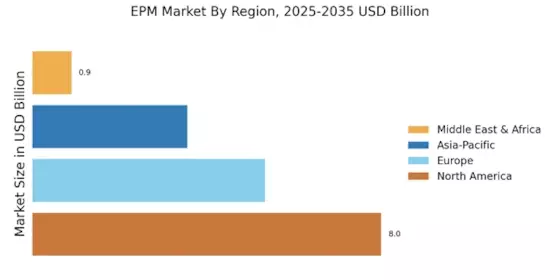Increased Demand for Real-Time Analytics
The EPM Market is currently experiencing a surge in demand for real-time analytics solutions. Organizations are increasingly recognizing the value of immediate data insights for decision-making processes. This trend is driven by the need for agility in business operations, allowing companies to respond swiftly to market changes. According to recent data, the market for real-time analytics is projected to grow at a compound annual growth rate of approximately 30% over the next five years. This growth is indicative of a broader shift towards data-centric strategies, where organizations leverage real-time information to enhance operational efficiency and customer satisfaction. As a result, the Epm Market is adapting to meet these evolving needs, offering solutions that facilitate timely data access and analysis.
Advancements in Technology and Automation
Technological advancements are significantly shaping the EPM Market, particularly through automation and enhanced software capabilities. The integration of advanced technologies such as artificial intelligence and machine learning is enabling organizations to streamline their EPM processes, resulting in increased efficiency and accuracy. Recent data suggests that companies utilizing automated EPM solutions can reduce planning cycles by up to 50%, allowing for more strategic focus on business growth. This trend indicates a shift towards more sophisticated EPM systems that can handle complex data environments and provide actionable insights. As a result, the Epm Market is witnessing a transformation, with vendors increasingly offering innovative solutions that leverage technology to optimize performance management.
Regulatory Compliance and Risk Management
In the EPM Market, the increasing complexity of regulatory requirements is driving demand for enhanced compliance and risk management solutions. Organizations are compelled to adopt robust EPM systems that can ensure adherence to various regulations while managing associated risks effectively. The financial sector, in particular, is witnessing heightened scrutiny, necessitating advanced reporting and analytics capabilities. Recent statistics indicate that companies investing in compliance technologies have seen a reduction in regulatory fines by up to 40%. This trend underscores the importance of integrating compliance features within EPM solutions, as organizations strive to mitigate risks and maintain operational integrity. Consequently, the Epm Market is evolving to provide tools that not only streamline compliance processes but also enhance overall risk management frameworks.
Rising Importance of Collaborative Planning
The EPM Market is witnessing a notable shift towards collaborative planning as organizations recognize the value of cross-departmental cooperation in the planning process. This trend is driven by the need for integrated strategies that align various business functions towards common goals. Recent studies indicate that organizations employing collaborative planning techniques experience a 20% improvement in forecasting accuracy. This improvement is crucial for effective resource allocation and strategic decision-making. As a response, the Epm Market is evolving to provide platforms that facilitate collaboration among stakeholders, enabling real-time data sharing and collective input in the planning process. This collaborative approach not only enhances the quality of plans but also fosters a culture of transparency and accountability within organizations.
Growing Focus on Sustainability and ESG Reporting
The EPM Market is increasingly influenced by the growing emphasis on sustainability and Environmental, Social, and Governance (ESG) reporting. Companies are under pressure from stakeholders to demonstrate their commitment to sustainable practices, which has led to a rise in demand for EPM solutions that facilitate comprehensive ESG reporting. Recent surveys indicate that over 70% of investors consider ESG factors when making investment decisions, highlighting the critical role of sustainability in corporate strategy. As organizations seek to align their operations with sustainable practices, the Epm Market is responding by offering solutions that integrate ESG metrics into financial planning and analysis. This alignment not only enhances transparency but also positions companies favorably in the eyes of socially conscious investors.


















Leave a Comment